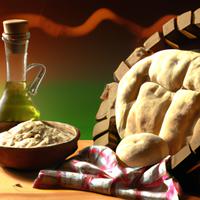
1 serving (50 grams) contains 130 calories, 4.0 grams of protein, 1.5 grams of fat, and 25.0 grams of carbohydrates.

Log this food in SnapCalorie

Nutrition Information
Calories |
619.0 | ||
|---|---|---|---|
% Daily Value* |
|||
| Total Fat | 7.1 g | 9% | |
| Saturated Fat | 1.0 g | 5% | |
| Polyunsaturated Fat | 0 g | ||
| Cholesterol | 0 mg | 0% | |
| Sodium | 952.4 mg | 41% | |
| Total Carbohydrates | 119.0 g | 43% | |
| Dietary Fiber | 7.1 g | 25% | |
| Sugars | 4.8 g | ||
| protein | 19.0 g | 38% | |
| Vitamin D | 0 mcg | 0% | |
| Calcium | 95.2 mg | 7% | |
| Iron | 5.7 mg | 31% | |
| Potassium | 238.1 mg | 5% | |
* Percent Daily Values are based on a 2,000 calorie diet. Your daily values may be higher or lower depending on your calorie needs.
Food Attributes
Source of Calories
About Low fermentation bread
Low-fermentation bread, often associated with modern baking techniques, is crafted using quick-rise methods or chemical leaveners like baking soda rather than traditional yeast fermentation. This type of bread is typically made from refined flour, water, salt, and a leavening agent, offering a softer texture and faster preparation time compared to sourdough or long-fermentation breads. Originating primarily from Western baking traditions, it caters to convenience over complexity. While low-fermentation bread is easy to produce and widely available, its nutritional profile can be less favorable. The lack of fermentation means fewer beneficial compounds, such as probiotics and prebiotics, are present. Additionally, refined flours are often low in fiber and nutrients. However, the simplicity of ingredients means it can avoid harmful additives found in processed foods. For a healthier option, choosing whole-grain varieties of low-fermentation bread can help balance its nutritional impact.



